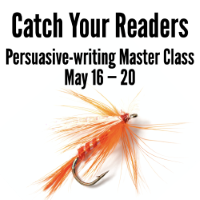Avoid losing readers in these hot spots
Fear appeals persuade. But they can also paralyze.

Strong fear appeals persuade … The stronger the fear appeal, the more likely it is to move your readers to act, according to 50 years of research and 100 studies reviewed by researchers Kim Witte and Mike Allen.
Weak fear appeals, on the other hand, don’t move audience members act.
… But they also paralyze. However, write Noah J. Goldstein, Steve J. Martin and Robert B. Cialdini in Yes!: 50 Scientifically Proven Ways to Be Persuasive, when you arouse fear without clearly showing how readers can reduce the danger, they may deal with the fear by blocking out the message.
To create a message that persuades your audience without paralyzing them, structure your fear appeal in four parts:
1. Introduce the threat.
The stronger the threat, the more effective the fear appeal. So:
A. Demonstrate the severity of the threat. Professional money managers, for instance, might reach out to trustees with a fear appeal like this:
“Individual trustees who are managing trusts on their own — even those who have appointed an investment advisor in a traditional trust arrangement — are personally responsible to the trust for the performance of those assets.”
B. Describe the threat using vivid word pictures. Illustrate the horrible consequences of the threat, as in this image from the World Wildlife Fund:
“Imagine (a group of dolphins) accidentally entangled in a fishing net, struggling for every single breath as they try to thrash their way to safety.”
C.Pile on references to the threat. Here’s how the Natural Resources Defense Council does it:
… The last gasp of a polar bear before it drowns in the vast waters of the Arctic, unable to reach the increasingly distant ice floes it needs to find food.
… The muffled cries of newborn polar bear cubs as they are buried alive when their snowy den collapses from unseasonable rains.
… The exhaustion of a mother polar bear and her young as they succumb to starvation after enduring longer and longer periods without food.
The stronger the threat, the more effective it will be.
2. Demonstrate that the reader is at risk.
Get the rest of the four-part fear appeal model >>>
____
Sources: Noah J. Goldstein, Steve J. Martin and Robert B. Cialdini; Yes!: 50 Scientifically Proven Ways to Be Persuasive, Free Press, 2009
Kim Witte and Mike Allen, “A Meta-Analysis of Fear Appeals: Implications for Effective Public Health Campaigns,” Health Education & Behavior, October 2000
Herbert J. Rotfeld, “There are threats and (maybe) fear-caused arousal: theory and confusions of appeals to fear and fear arousal itself,” Journal of Advertising, Sept. 22, 1997
Richard Tay, Barry Watson and Olivia Radbourne, “The influence of fear arousal and perceived efficacy on the acceptance and rejection of road safety advertising message,” Road Safety Research, Policing and Education Conference (Regain the Momentum), Melbourne, 2001
How do you write messages that readers want to read?
If you want to Catch Your Readers, you need to think like a reader. Then you need to use the bait your reader likes, not the bait you like.
 So what’s the bait the reader likes?
So what’s the bait the reader likes?
Learn a four-step process for making your message more relevant, valuable and rewarding to your audience at Catch Your Readers, our persuasive-writing workshop starting May 16.
There, you’ll learn the formula readers use to determine which messages to read. Discover two rewards you can use to boost audience interest in your message. And learn a magic word that focuses reader attention on your message.
Save up to $100 with our group discounts.
